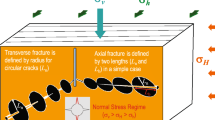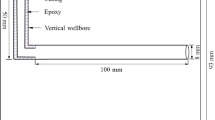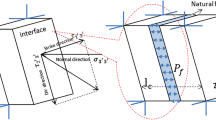Field experience shows that horizontal well multi-stage fracturing technology can transform the volumetric pressure crack network in the formation and has been widely used in unconventional oil and gas resource exploitation. According to the requirements of horizontal well fracturing operations, this paper simulates the law of horizontal well fracturing in low-porosity and low-permeability sand-shale formation by large-mold fracturing tests and analyzes crack initiation and extension. The two completion methods of open-hole completion and casing perforation completion are considered, and the maximum and minimum horizontal principal stress difference is 10 and 4 MPa. The horizontal wellbore azimuth angle changes from 0° to 90°. The test results show that the principal stress difference has a great influence on fracture initiation. The smaller the stress difference, the higher the fracture initiation pressure and the more complicated the fracture initiation and extension. The fracture propagates along the axial direction of the wellbore, and then at both ends of the wellbore the fracture turns to the direction perpendicular to the direction of the minimum horizontal principal stress. The horizontal wellbore can form a transverse fracture by drilling along the direction of the minimum horizontal principal stress. This study is of great significance for understanding the fracture initiation and propagation law of horizontal well fracturing and can provide guidance for multi-stage fracturing operations of horizontal wells in unconventional reservoirs.
Similar content being viewed by others
Avoid common mistakes on your manuscript.
Horizontal well drilling and completion and fracturing treatment technology have become increasingly important technologies for the efficient development of low permeability reservoirs, especially for the commercial exploitation of unconventional oil and gas resources such as shale gas and tight sandstone gas [1]. Understanding the law of horizontal well fracturing crack propagation is of great significance for optimizing volume fracturing design and guiding on-site construction.
Since Giger [2] first proposed the concept of horizontal well fracturing, and many scholars at home and abroad have studied the theory of horizontal well fracturing. Hossain et al. [3, 4] investigated the fracture pressure of stratum rock under various conditions such as open hole completion and perforation completion in horizontal wells and derived the formula of the angle between crack initiation direction and wellbore axis. Cheng Yuanfang et al [5] analyzed the characteristics and basic principles of horizontal well fracturing from the perspective of rock mechanics, pointing out that crack initiation and fracture morphology mainly depend on overburden pressure σv, maximum horizontal principal stress σH minimum horizontal principal stress σh, and size and orientation of the horizontal wellbore. At present, the understanding of hydraulic fracturing mechanism is still limited. In theoretical research on the crack geometry, the authors often use idealized and simplified two-dimensional or three-dimensional models. These theoretical studies have not been validated.
Hydraulic fracturing test simulation is an important method of studying the mechanism of hydraulic crack initiation. There are many studies on simulation of vertical well fracturing tests but not many works on horizontal fracturing simulation. Kim et al. [6] have studied the crack initiation and geometry problems for different completion methods, ignoring the influence of the principal stress difference (the difference between maximum horizontal principal stress σH and minimum horizontal principal stress σh). The test conditions were very different from field fracturing operations. In [7,8,9,10] the authors studied horizontal well fracturing simulation under conditions close to the requirements of on-site construction for casing perforation completion (indicated by T) and under different conditions of maximum horizontal principal stress and minimum horizontal principal stress, crack initiation pressure and geometry, and different azimuth angles θ (i.e., horizontal wellbore axial direction). The relationship between fracture characteristics and the angle with the minimum horizontal principal stress direction is of great significance for further study of the fracture initiation and extension mechanism of hydraulic fractures in horizontal wells.
The horizontal well fracturing simulation test simulates a low porosity and low permeability sand-shale reservoir with a depth of 2000 m. The stress relation is as follows: σv > σH > σh. The main petrophysical parameters are the following: permeability k 0.1-0.5 mD, porosity φ 5-8%, Young’s modulus of core E 28 GPa, and Poisson’s ratio γ 0.25. The artificial rock sample for simulation tests was prepared by compressing a special sand and cement mixture in a special mold. The size of the rock sample is 105 × 105 × 105 mm. According to the similarity criterion, the horizontal section length is 65 mm, the simulated wellbore diameter is 10 mm, and the casing perforation diameter is 1 mm. The fracturing fluid injection rate was 9 ml/min, and the fracturing fluid was a vegetable gum (0.55% GRJ-11 + 0.3% HTC-160) with viscosity 60 MPa∙s. The rock sample model is shown in Fig. 1.
The test simulates the process of horizontal well fracturing for open hole and casing perforation completion methods under two stress difference conditions. Two different completion methods were selected, and the azimuth angles of the wellbore were simulated at five angles of 0°, 30°, 45°, 60°, and 90°. A total of four groups of tests, each group consisting of five fracture simulation tests, was performed. The casing adopts the 90° phase spiral perforation method.
Figure 2 shows the crack initiation and extension pressure for different azimuth angles. It can be seen that when the azimuth angle of the wellbore is between 0° and 45°, the crack initiation pressure and the extension pressure decrease with increase in azimuth angle. For azimuth angles around 45°, the pressure values obviously increase. When the azimuth angle is in the range of 45° ~ 90°, the crack initiation pressure decreases with the azimuth angle, and the extension pressure also decreases moderately. Compared with the open hole completion, in the case of casing perforation the cracks start from the points of perforation. The cracking and extension pressures are both high, and the crack initiation pressure and extension pressure of the two completion methods are higher than the stress difference of 10 MPa and the stress difference of 4 MPa. The test results show that when the wellbore azimuth is small, the fracturing may form a transverse joint. When the wellbore does not follow the maximum and minimum principal stress directions, multiple cracks or nonlinear cracks are formed. When the azimuth angle is 45° or near it, the crack initiation and extension mechanism is complicated and depends on the completion method and the main stress difference in the rock sample. The larger the main stress difference, the more favorable the crack initiation. This is consistent with results of theoretical calculations and numerical simulations [11,12,13].
The crack geometry reflects the crack initiation and extension law. When the wellbore azimuth is 0°, the crack both splits and extends in a direction perpendicular to the direction of the minimum horizontal stress, in the same vertical plane as the axis of the wellbore. At the end of the horizontal wellbore, the crack changes direction and further develops along the minimum horizontal principal stress direction. If the rock sample size is large enough, a transverse joint may be formed.
When the azimuth angle is 30° (Fig. 3), the crack starts perpendicular to the direction of the wellbore and then turns to the maximum horizontal principal stress direction at a distance equal to the wellbore diameter. The fracturing mechanism has the characteristics of multi-fracture cracking, particularly outside the rock sample. The crack develops in a direction perpendicular to the minimum principal stress.
When the azimuth angle is 45° (Fig. 3), the crack initiation mechanism is more complicated and includes cracks caused by tensile and shear failure. The open hole completion crack starts along the wellbore direction and at a distance from the wellbore equal to the wellbore radius. It can be clearly seen that parallel cracks start to turn perpendicular to the minimum horizontal principal stress direction, and a main crack is formed in the periphery of the rock sample. For casing perforation completion, when the principal stress difference is 4 MPa (T-45-4), each perforation hole acts as a crack initiation point, the fracture is perpendicular to the minimum horizontal principal stress direction, and the crack is maximum at the end of the wellbore. The stress direction is expanded. When the principal stress difference is 10 MPa (T-45-10), the crack shape is relatively simple.
When the azimuth angle is 60° (Fig. 3), the crack initiation is mainly caused by tensile failure. For the open hole wellbore, the crack starts along the axis of the wellbore and extends to the periphery of the rock to form a crack plane. At both ends of the wellbore the crack extends perpendicular to the direction of the minimum horizontal principal stress. For perforated wells, when the principal stress difference is 4 MPa (T-60-4), the cracks are initiated at each perforation point, and all perforations are respectively connected by cracks. Crack extension is basically the same as that of the open hole completion. When the main stress difference is 10 MPa (T -45-10), the stress concentration is located at the junction of the vertical and horizontal sections. The cracks are initiated in the direction of the wellbore axis at the first perforation point (the wellbore bend point) and extend along the maximum horizontal principal stress to the periphery of the rock sample.
When the azimuth angle is 90° (Fig. 3), the cracks in both completion modes are perpendicular to the minimum horizontal principal stress and form a longitudinal plane. The casing completion causes crack initiation at each perforation point. At the point, the cracks form fractures along the axial direction of the wellbore.
Through the analysis of the above test results, the following aspects of the horizontal wellbore fracturing can be concluded. The main stress difference has a great influence on the crack initiation pressure. Prior to the design of fracturing process, in order to predict the construction pressure and fracture geometry, one should fully investigate the physical properties of the reservoir rock, especially the geostress data of the formation. The horizontal well fracturing completion method is also important. If the formation strength is high enough and stable, and the wellbore stability can be maintained during the life of the well, it is preferred to use open hole completion because it can maximize the connection between the wellbore and the fracture be considered.
For a reservoir with a large thickness, the azimuth angle of the wellbore is small, while for a thin reservoir, the azimuth angle of the wellbore is generally large and the wellbore is located in the reservoir. For casing perforation completion, the large depth of perforation is beneficial to reduce the unfavorable factors that cause multi-crack initiation and extension. Due to its special reservoir properties, the use of horizontal well multi-stage fracturing technology in shale gas development has achieved great success. It is known from the test analysis that when horizontal drilling is carried out in multiple stages along the direction of minimum horizontal principal stress, a transverse crack can form that expands the reservoir transformation volume.
Through the indoor test simulation analysis of the law of crack initiation and extension of horizontal well fracturing, the following conclusions can be drawn:
-
(1)
The main stress difference has a great influence on crack initiation. The greater the stress difference, the lower the cracking pressure and the easier it is to perform fracturing; the smaller the stress difference, the higher the cracking pressure and the more complicated the crack initiation and extension.
-
(2)
For the same azimuth angle, the crack initiation and extension characteristics of the two completion methods are similar, and the fracture initiation and extension pressure of the open hole completion are lower than that of the casing perforation completion.
-
(3)
For each completion method, as the azimuth of the horizontal wellbore increases, the crack initiation angle first increases from 0°, then gradually decreases to 0°; the casing perforation causes crack initiation in almost every point of perforation, and a main crack is formed in the course of the extension process.
-
(4)
For wells with azimuth angles between 0° and 90°, fractures crack along the axial direction of the wellbore and extend to form a major crack. When the fracture extends to both ends of the wellbore, it eventually turns perpendicular to the direction of the minimum horizontal principal stress.
References
J.Yuan, R.Jiang, W.Zhang, et al., “The workflow to analyze hydraulic fracture effect on hydraulic fractured horizontal well production in composite formation system,”Adv. Geo-Energ. Res., 2, 319-342 (2018).
F.M. Giger et al., “Horizontal wells production techniques in heterogeneous reservoirs,” SPE, 13, 7-10 (1985).
M.M. Hossain, M.K. Rahman, S.S. Rahman, et al., “A comprehensive monography for hydraulic fracture initiation from deviated bores under arbitrary stress regimes,” SPE, 5, 43-60 (2000).
D.G. Crasby et al., “Single and multiple transverse fracture initiation from horizontal wells,” JPSE, 35, 191-204 (2002).
Y.F. Cheng, G.H. Wang, R.H. Wang, et al., “Rock mechanics problems in horizontal well fracturing,” Rock Mech. Eng., 14, 2463-2466 (2004).
C. M. Kim, H.H. Abass, et al., “Hydraulic fracture initiation from horizontal wellbores: laboratory experiments,” ARMA-91 -231, 6191-194X (1991).
Z.K. Hou, C.H. Yang, L. Wang, et al., “Hydraulic fracture propagation of shale horizontal well by large-scale true triaxial physical simulation test,” Rock Soil Mech., 7, 407-414 (2016).
R.Z. Huang et al., “Initiation and extension of hydraulic fracturing,” J. Pet. Explor. Dev., 1, 6274 (1981).
F. Yao, M. Chen, X.D. Wu, et al., “Physical simulation of hydraulic fracture propagation in naturally fractured formations,” Oil Drill. Prod. Technol., 30, 8386 (2008).
B.Haimson, C. Fairhurst, et al., “Initiation and extension of hydraulic fractures in rocks.” Soc. Pet. Eng. J.,7,310318 (1967).
J.G. Xu, Z.D. Liu, Y.X. Dong, et al., “Research on man-made fracture break regulars and treatment countermeasures in fractured horizontal well,” Drill. Prod. Technol., 32, 36-38 (2009).
X.T. Shang, S.L. He, G.F. Liu, H. Liu, J.H. Hu, et al.,”Breakdown pressure calculation of staged fracturing for horizontal wells,” Oil Drill. Prod. Technol., 31(2), 96-100 (2009).
F. Kevin, W. Norm., et al., “Hydraulic fracture-height growth: real data,” SPE Prod. Oper., 27(1), 8-19 (2012).
Author information
Authors and Affiliations
Corresponding author
Additional information
Translated from Khimiya i Tekhnologiya Topliv i Masel, No. 3, pp. 57 – 60, May – June, 2020.
Rights and permissions
About this article
Cite this article
Yang, L., Cao, J., Tao, Z. et al. Fracture Propagation Characteristics in Horizontal Wells. Chem Technol Fuels Oils 56, 405–410 (2020). https://doi.org/10.1007/s10553-020-01151-5
Published:
Issue Date:
DOI: https://doi.org/10.1007/s10553-020-01151-5







